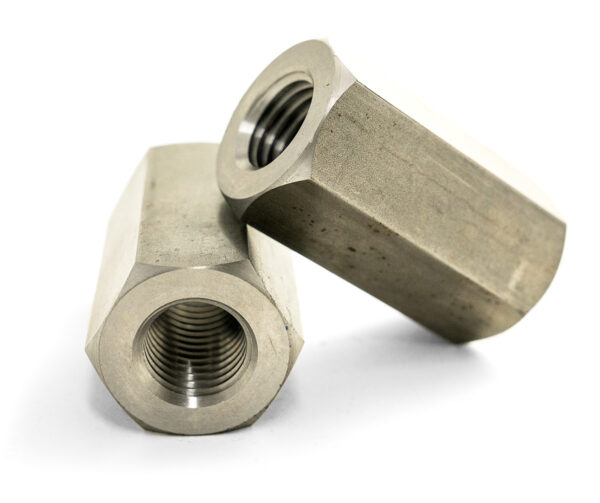Coupling Nuts | Technical Insights from Portland Bolt

Coupling Nuts—also known as extension nuts—are elongated fasteners engineered to join two male threads, such as threaded rods or bolts. Ideal for both industrial and structural uses, these nuts offer strength, adjustability, and a range of customization options.
Manufacturing: Manufactured with precision using modern processes—discover our full manufacturing capabilities.
Grades: Whether you need standard or heavy-hex coupling nuts, explore our available coupling nut grades.
Dimensions: Available in various thread sizes and physical dimensions to suit your project needs.
Coupling Nut Types
Hex Coupling Nuts
These traditional hexagon-shaped nuts are available in Unified National Coarse threading, in plain and hot-dip galvanized finishes. Discover the grades we offer and our manufacturing standards in more detail.
Heavy Hex Coupling Nuts
With thicker walls and wider flats, these are designed for higher load-bearing applications, though they can be manufactured to both low-strength and high-strength specifications. You can view their material specs and availability on the grades page, or learn more about how they’re produced under manufacturing. These coupling nuts are often not readily available in the marketplace.
Sleeve Nuts
A sleeve nut is a specialized coupling nut that is essentially a long, internally threaded nut. It is different from a coupling nut in that it is longer and threaded left-hand on one end and right-hand on the other. Learn more about this specialized coupling nut on our sleeve nut page.
Reducing Coupling Nuts
Designed to connect rods or bolts of differing diameters—find exact dimension data on our dimensions page. One side has a different internal thread diameter from the other.
Round Coupling Nuts
Featuring a cylindrical design (with optional wrench flats), these are ideal when aesthetics or rapid production are priorities.
Stop Type Coupler
Incorporating an internal stop to regulate insertion depth, these are crucial for structural uses like rebar splicing. See real-world scenarios for these and other coupling nuts in our applications section.
Benefits of Using Coupling Nuts:
Durability: Provides a strong and secure connection for high-load applications.
Adjustability: Can fine-tune tension or alignment by tightening or loosening.
Ease of Use: Simple design allows for quick and efficient connections without specialized tools.
Customizability: Available in various materials (e.g., stainless steel, zinc-plated steel) and thread sizes to meet different requirements and applications.
Quick FAQ – Coupling Nuts
Coupling nuts come in carbon steel, stainless steel, and alloy steel, with finishes like zinc plating and hot-dip galvanizing for corrosion resistance.
Standard sizes range from 1/4” up to 4” in diameter, with UNC, UNF, Acme, and metric threads available.
Yes. Stainless steel and hot-dip galvanized coupling nuts provide excellent corrosion protection for outdoor and marine applications.
